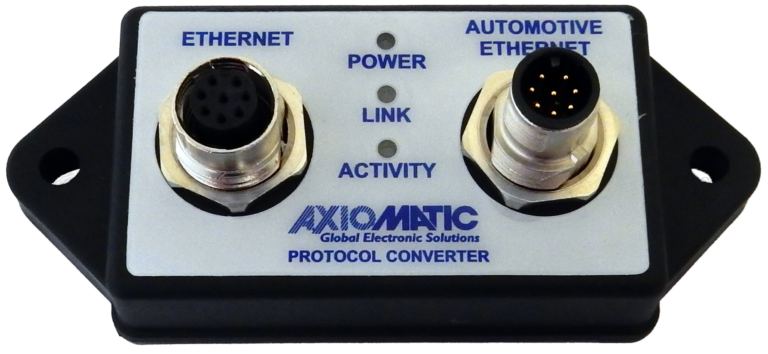Bishoy Mansour, technical sales specialist at Axiomatic Technologies Corporation explains how automotive Ethernet can revolutionise vehicle networks
The need for fast communication in vehicles is driven by the growing number and sophistication of electronic control systems. Automotive Ethernet (AE) is key in the future of networking technology, providing a high-speed, low latency network physical layer specifically for vehicles. In contrast to ethernet which uses two twisted pairs of wire, AE uses a single pair of twisted wire. This reduces costs by making the cabling lighter and more space efficient.
Understanding the benefits
AE’s high data rates enable fast and large-scale data communication. Low latency means minimal delay, which is vital for real-time applications such as safety cameras on off-highway vehicles. Moreover, AE offers reliable noise resistance making it a trustworthy choice for in-vehicle networking.
As vehicle electronics become more complex, AE’s high bandwidth and flexibility make it ideal for connecting to cloud services and industrial applications. Its scalability and use of familiar communication protocols make updates and maintenance easier. This is transforming AE into the backbone of future automotive networks.
The standardisation of AE involves the IEEE setting specific requirements to ensure interoperability and reliable performance in vehicles. It was first deployed via OABR (Open Alliance BroadR-Reach) in 2016 before evolving to 802.3bw (100BASE-T1), 802.3bp (1000BASE-T1) and 802.3cg (10BASE-T1L) for the longer cable lengths in process automation. These standards enable various ethernet speeds to coexist within one vehicle architecture without complex protocol conversions, facilitating scalability. Strict testing ensures signal integrity and minimal noise, crucial for the advanced functions of modern vehicles.
Design and application
Although the development in this technology is led by the automotive industry today, demand for it continues to expand into the off-highway, mining, and agriculture industries. These sectors have recently included more sophisticated safety cameras, lidars, autonomous driving algorithms that need a high bandwidth solution. We at Axiomatic understand and appreciate the degree of ruggedness and reliability needed for these types of applications, and we design our AE products with that mindset.
Axiomatics’ design approach consistently aims to bridge the gap between modern and innovative technology. The Gigabit Ethernet (1000BASE-T) to Gigabit AE (1000BASE-T1) converter, AX141550, ensures a seamless connection through the physical layer with no packet losses, effectively bridging these technologies. It can also convert 100BASE-TX (802.3u) to 100BASE-T1 (802.3bw) making it a versatile solution.
The AE-CAN converter, AX141530, enables communication across different automotive sub-systems. This is particularly useful for monitoring or viewing diagnostics of multiple sub-systems simultaneously.
The 6-port AE switch, AX141570, allows users to link and control six different networks. It can be configured as 100Mbps or 1Gbps connections on each port. Generally, 100Mbps are for devices with lower bandwidth and 1Gbps are for higher bandwidth devices or main processing units. The Rotary Laser Receiver, AX064020, can be configured to detect up to two independent rotary lasers and communicates through Automotive Ethernet.
Product development
Axiomatic is evaluating all the platforms for automotive ethernet including 802.3ae (10GbE) for use in product development. We collaborate closely with OEMs to understand and address their needs to ensure a good solution for them. This rigorous process aims to deliver state-of-the-art solutions that drive innovation and advancement in technology.





